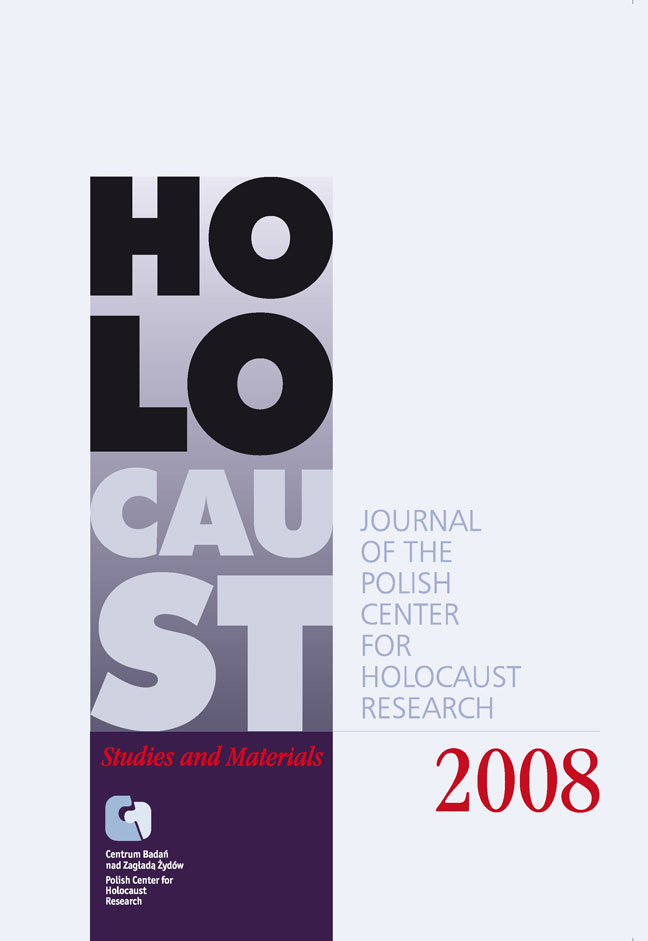Błoński’s Essay Years Later
Zagłada Żydów. Studia i Materiały, 2008, Strony: 23-30
Data zgłoszenia: 2020-09-25Data publikacji: 2008-12-01
 https://doi.org/10.32927/ZZSiM.55
https://doi.org/10.32927/ZZSiM.55
Abstrakt
The author reflects upon Jan Błoński’s essay “Biedni Polacy patrzą na getto” (Poor Poles look at the ghetto) nearly twenty years of its publication by Tygodnik Powszechny. He points at the innovative character of the depiction of Polish-Jewish issues in the moral context, outside of all the political embroilments. Błoński’s voice is unique, because it acknowledges, in the spirit of the Gospels, that analysis of Polish- -Jewish relations is a fundamental issue for the Polish society, a “homework” that needs to be done. This essay, Głowiński claims, is free from the embroilment in the dualism of the negative and positive myths regarding these relations. The author writes about reactions to this text, the letters to the editor and notes one particular voice, which he reads as an internalised nationalist ideology and the dangerous continuation of the nationalist discourse. Głowiński’s sketch concludes the post scriptum, in which the author refers to another article, published in 2006 by Gazeta Wyborcza, regarding the current historical policy, whose proponents see Błoński’s essay as a negative reference
point. The author notes that this essay constantly evokes strong emotions, and, as an expression of critical patriotism, still has its ardent opponents.
Licencja
Prawa autorskie (c) 2008 Autor & "Zagłada Żydów. Studia i Materiały"

Utwór dostępny jest na licencji Creative Commons Uznanie autorstwa 4.0 Międzynarodowe.
https://creativecommons.org/licenses/by/4.0
Inne teksty tego samego autora
- Michał Głowiński, Jan Błoński "Biedni Polacy patrzą na getto” w 20 lat później , Zagłada Żydów. Studia i Materiały: Nr 2 (2006)
- Michał Głowiński, Oczy donosiciela , Zagłada Żydów. Studia i Materiały: Nr 10 (2014)
- Michał Głowiński, Mordechaj Chaim Rumkowski – postać rzeczywista i bohater legend , Zagłada Żydów. Studia i Materiały: Nr 9 (2013)
- Michał Głowiński, Życiorys Batji Klig , Zagłada Żydów. Studia i Materiały: Nr 7 (2011)
Podobne artykuły
- Karin Ohry-Kossoy, Agnieszka Haska, Lista Soni Wajselfisz [Karin Ohry Lista Soni; Agnieszka Haska, „Setki znajomych osób”. Lista z Bergen-Belsen] , Zagłada Żydów. Studia i Materiały: Nr 12 (2016)
- Karolina Sulej, Jacek Leociak, „Uśmiechał się do mnie i przesyłał mi ręką pocałunki”. O relacji Dory Sztatman , Zagłada Żydów. Studia i Materiały: Nr 5 (2009)
- Barbara Engelking, “We are competely dependent on them . . .” – relations between the helpers and the hiding as exemplified by Fela Fischbein’s diary , Zagłada Żydów. Studia i Materiały: 2010: Holocaust Studies and Materials
- Stephan Stach, „Duch czasu wycisnął jednak na tej pracy swe piętno”. Historia Zagłady w badaniach Żydowskiego Instytutu Historycznego w okresie stalinowskim , Zagłada Żydów. Studia i Materiały: Nr 13 (2017)
- Havi Dreifuss, „Oni wciąż we mnie żyją”. Israel Gutman (1923–2013): ocalały z Zagłady, uczestnik powstania w getcie warszawskim, historyk żydowski , Zagłada Żydów. Studia i Materiały: Nr 10 (2014)
- Jacek Partyka, Literackie formy graniczne (Weiss – Reznikoff – Grynberg) , Zagłada Żydów. Studia i Materiały: Nr 9 (2013)
- Tomasz Sierwierski, Feliks Tych. Historyk (ocalały z) Zagłady , Zagłada Żydów. Studia i Materiały: Nr 17 (2021)
- Yehuda Bauer, Powstanie w getcie warszawskim. Nowe spojrzenie , Zagłada Żydów. Studia i Materiały: Nr 14 (2018)
- Justyna Majewska, „Czym wytłumaczy Pan…?” Inteligencja żydowska o polonizacji i asymilacji Żydów w getcie warszawskim . , Zagłada Żydów. Studia i Materiały: Nr 11 (2015)
- Jacek Leociak, Ruta Sakowska (1922–2011) , Zagłada Żydów. Studia i Materiały: Nr 7 (2011)
<< < 6 7 8 9 10 11 12 13 14 15 16 17 18 19 20 21 22 23 24 25 26 27 28 29 30 31 32 33 34 35 36 37 38 39 40 41 42 43 44 45 46 47 48 49 50 51 52 53 54 55 > >>
Możesz również Rozpocznij zaawansowane wyszukiwanie podobieństw dla tego artykułu.
 English
English
 Język Polski
Język Polski








